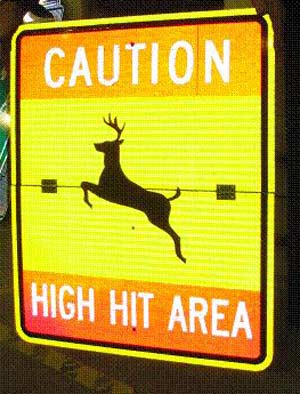Drivers Urged to Heed New Roadside Warning Signs and Watch Out for Deer

AUGUSTA, Maine –-(Ammoland.com)- The arrival of spring means deer are on the move along roadways. MaineDOT and the Maine Department of Inland Fisheries and Wildlife are urging drivers to heed posted warning signs and slow down, particularly in areas where historically a high number of deer-vehicle collisions have occurred.
As snow slowly disappears this spring, areas along the sides of roads are generally one of the first areas to green up with vegetation. Deer, who have been feeding on poor quality food throughout much of the winter, flock to roadsides where they can feast on tender, green plants. As deer disperse from areas where they have wintered, motorists will often see deer feeding along the sides of roads. Often these areas are along the sides of major highways or high speed routes.

Recognizing the need to protect both motorists and deer, MaineDOT and MDIF&W have identified several seasonal areas where there are a high number of deer crashes and have installed unique signs that alert motorists to deer during this peak season. These signs are generally specific to a 1-mile or less stretch of road with very high collision rates. It is extremely important that motorists watch for these signs and slow down.
“It’s a scenario we don’t like to see happen – a car hitting a deer, injuring the driver and the animal,” said MDOT Commissioner David Bernhardt. “Unfortunately, it does happen too often. Please, heed the roadside warning signs and be alert for deer that may want to cross in your path. Save your life, and that of the deer.”
These “Caution — High Hit Area” signs feature a silhouette of a deer, and are a bright, reflective orange and yellow. These signs are foldable signs, and they are only opened and displayed during this time of year, when deer collisions are frequent. As deer disperse away from the roads, these signs will be folded up by MDIF&W personnel so drivers do not become accustomed to them. Next year, they will be unfolded as deer start to move.
These signs were recently installed at a high deer crash area along I-95 in Sherman. That particular stretch of highway is located alongside a deer wintering area, and crosses a traditional travel corridor used heavily by deer.
“As we work to reduce mortality factors on deer and rebuild Maine’s deer population, alerting motorists to these high-hit areas is critical,” said MDIF&W Commissioner Chandler Woodcock. “By slowing down and using extra caution in these limited-but-distinct sites, drivers have an opportunity to save a deer.”
Over the past two years, these orange-and-yellow signs have been installed at the following locations where there has been a history of deer/vehicle crashes during this time of year: Route 9-Amherst, Route 9-Wesley, Route 193-Cherryfield, Route 191- Jacksonville, Route 1-Edmunds, Route 1 in East Machias, Route 2-Oakfield, Route 212-Smyrna Mills and Route 1-Monticello.
Motorists who see these new signs should be aware that deer are likely in the area, and should drive accordingly. Remember, these signs are only erected during high risk periods for a specific section of road.
Over the past 10 years, Maine has averaged over 3,000 deer-vehicle crashes each year. Drivers should take care this time of year, and be on the lookout for all wildlife on the sides of the road. Motorists should reduce their speed when it is dark, use high beams where appropriate, and always wear their seatbelt.
